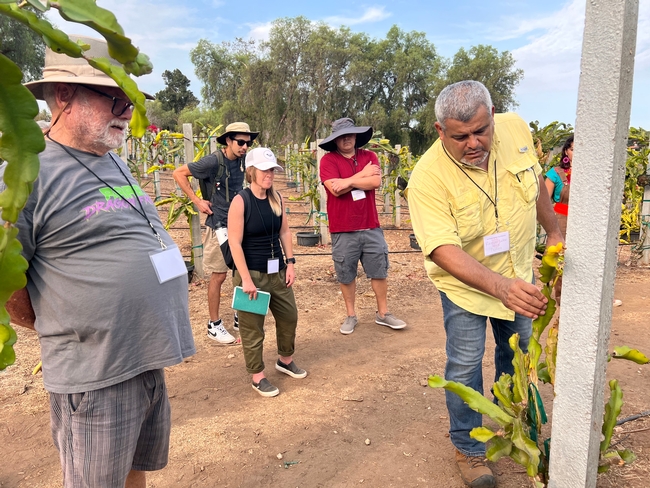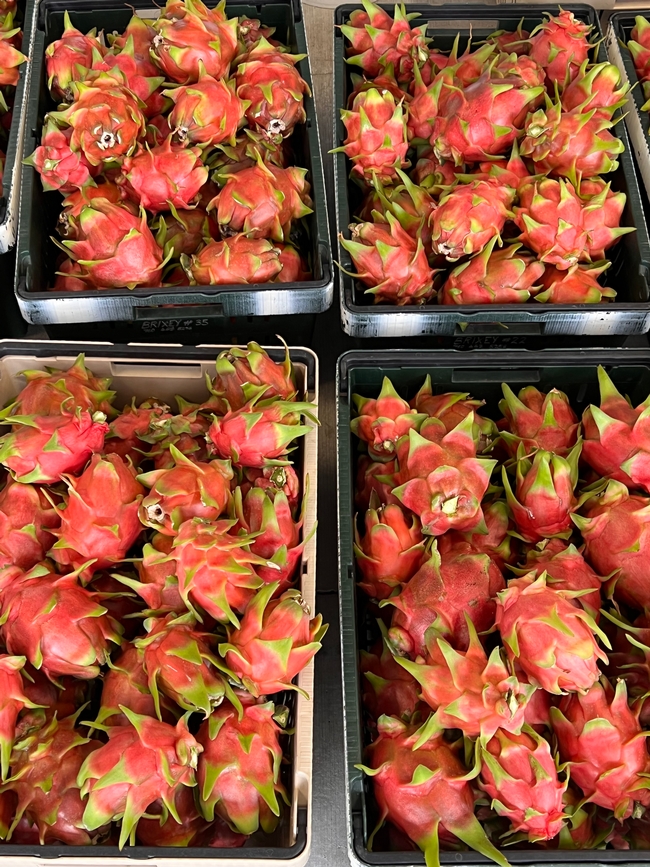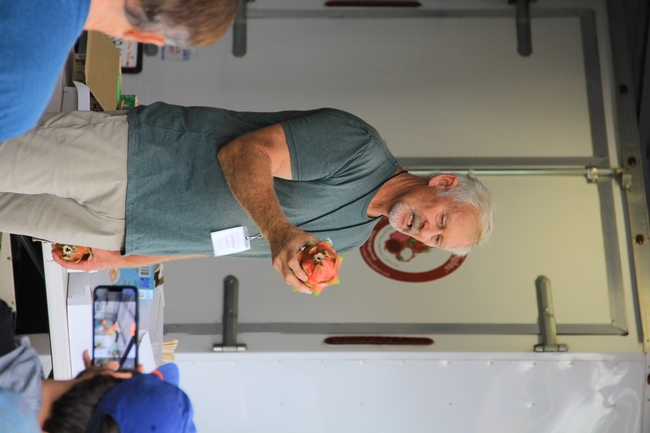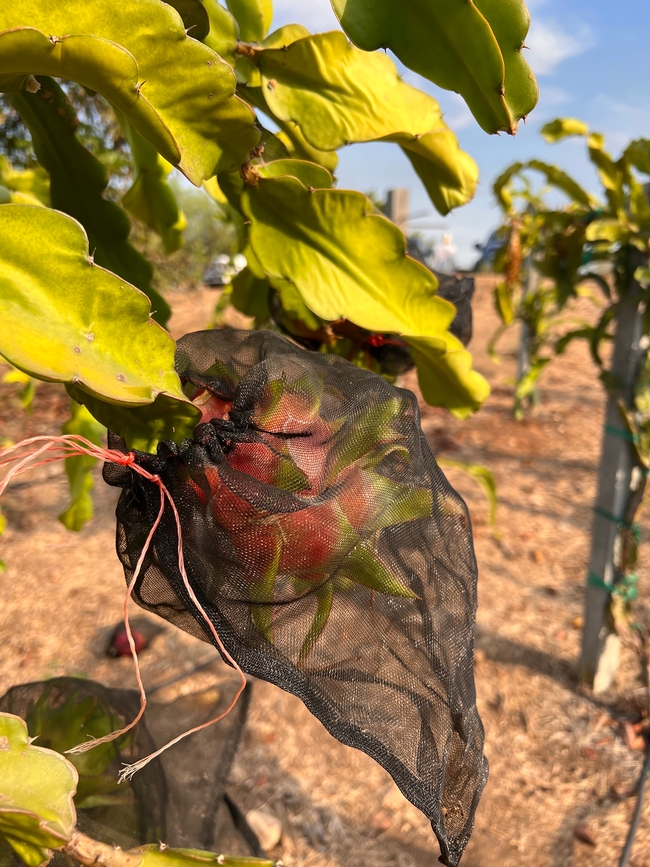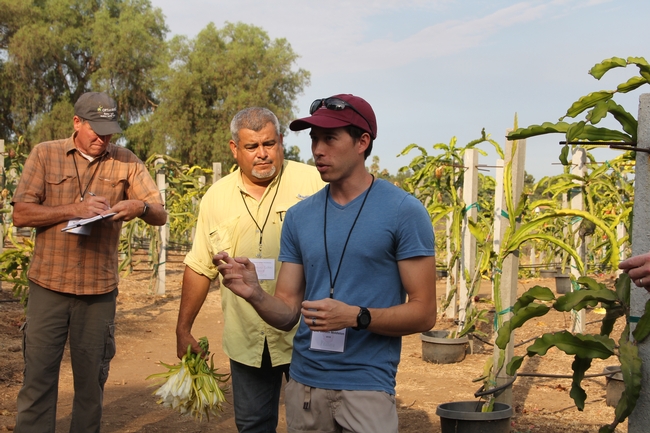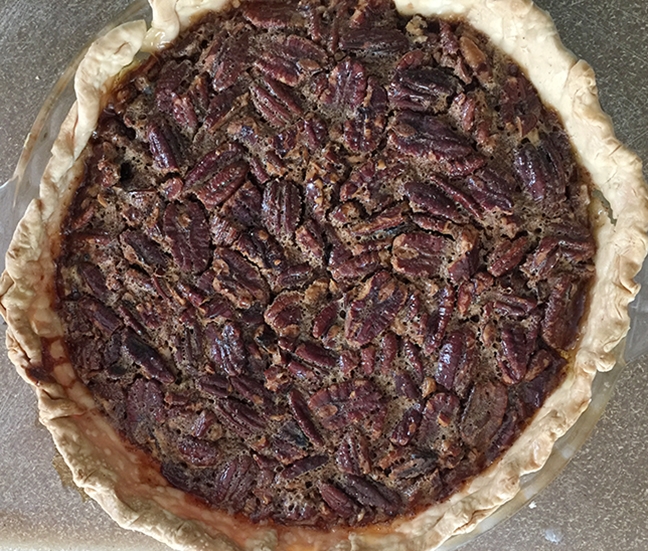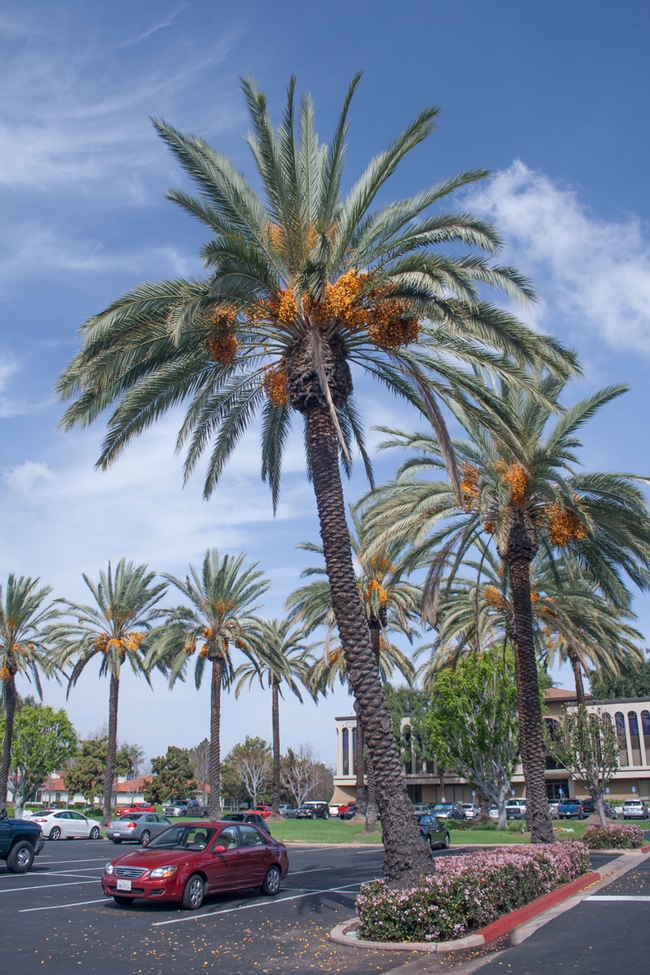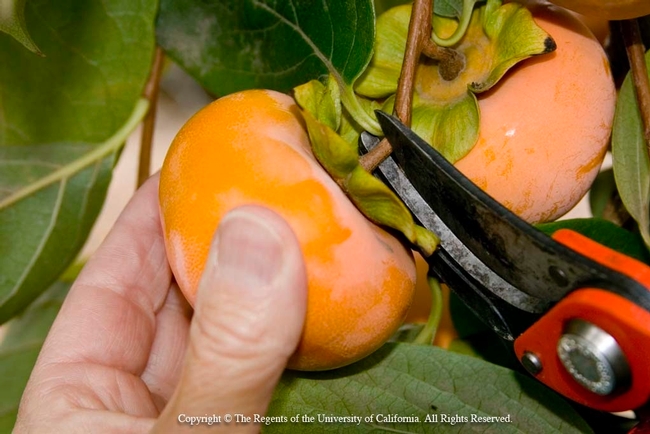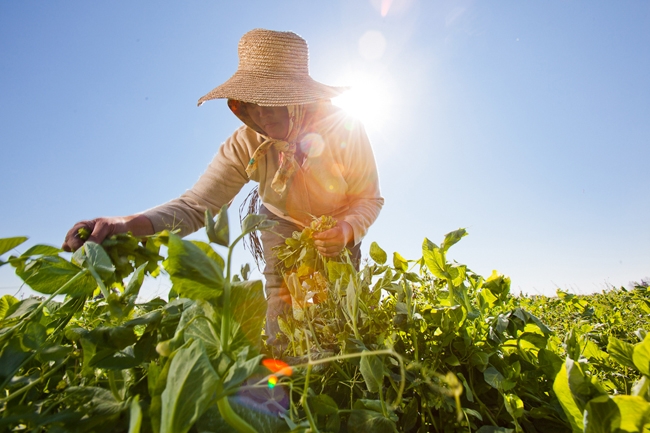Posts Tagged: fruit
Pitahaya/dragon fruit growers gather to learn from UCCE research and each other
Once you know what a dragon fruit looks like, you will never forget it. The bright red, sometimes yellow or purple, scaly skin makes for a dramatic appearance. One that will surely leave an impression. The flesh ranges from white to a deep pink and the flavor is often described as having hints of kiwi, watermelon, or pear.
Since 2007, the Pitahaya/Dragon Fruit Production Tour, has united dragon fruit growers of all levels and backgrounds. After a two-year hiatus due to the pandemic, registration for the 2022 tour filled up in less than 24 hours.
A group of 60 participants gathered Sept. 8 at the Wallace Ranch Dragon Fruit Farm in Bonsall to learn the latest research on growing the drought-tolerant specialty crop. Ramiro Lobo, a small farms and agricultural economics advisor for UC Cooperative Extension in San Diego County, introduced dragon fruit growers and other UC scientists.
“I can't remember a year where this event was not sold out. So, the need and demand is there,” said Eyal Givon, a long-time participant and dragon fruit grower.
The tour not only demonstrates how to grow the fruit, but it also grants participants access to plant material for varieties that are unavailable elsewhere.
“We have given out about 50,000 cuttings through our festival and some varieties were unique to us because we introduced them to the U.S.,” said Lobo.
During their time at Wallace Ranch, participants heard from the farm's owner, Neva Day, regarding the growing practices that have shaped her success today. Day has been growing organic dragon fruit since 2013 and has well over 5,000 plants on the ground and more than 20 varieties.
Eric Middleton, UCCE integrated pest management area advisor for San Diego County, talked about managing insects and pests that growers are likely to encounter such as Argentine ants.
According to Middleton, Pecan Sandies are a balanced source of fat, protein, and sugar, making them excellent bait for the sugar-loving insects.
Participants eventually made their way to Dragon Delights Farm located in Ramona. Kevin Brixey, the farm's owner, has been growing organic dragon fruit for six years.
Although Brixey was hosting this year's tour participants, he used to be one of them.
“I attended the Pitahaya Festival in 2014 and that's where I realized dragon fruit was something I could grow. There was a lot of good information being shared and a connection to other growers, so it was a major steppingstone for me,” he says.
Unlike traditional dragon fruit growers, Brixey uses shade to grow his dragon fruit after learning about the method from another grower.
“I was impressed. I liked how the fruit performed under shade and now I use it as a management tool,” Brixey explained. In Inland Valleys, shade can shield fruit from intense sunlight and protect them from unwanted guests that eat the fruit, such as birds.
At the Farm Bureau of San Diego County offices, participants learned about the history of dragon fruit growing in California, food safety, pest management, best production practices and much more.
The presenters included experts like Paul Erickson from Rare Dragon Fruit, Lobo, Middleton, Johanna del Castillo from UC Davis Department of Plant Pathology and Ariana Reyes, a community education specialist from UCCE San Diego.
When reflecting on his time participating in the production tour, Givon, who has been growing dragon fruit for about 20 years and manages a 20-acre farm in Moorpark, said he enjoys reconnecting with other growers the most.
“What others are doing, might be better than what I'm doing,” Givon said. “Or what I'm doing, could be better than what someone else is doing. This time together is good for us to learn from each other.”
Lobo agreed with Givon and added, “I hope that these tours become self-sustained, and that we go back to a research field day at Southcoast REC with regional tours in San Diego and Ventura as we did before, or any other counties.”
The Pitahaya/Dragon Fruit Production Tour is an annual event hosted by UCCE San Diego. To learn more about UCCE San Diego events, visit https://cesandiego.ucanr.edu.
Pecan pie: A holiday tradition and a treat
“Ahh, nuts!”
This time of year, you're probably thinking “Ahh, pecans!”
And particularly, “Ahh, pecan pie!”
We do love our pecans. The U.S. produces 80 to 95 percent of the world's pecans, and most are grown in Georgia, according to the UC Davis Fruit and Nut Research and Information Center (FNRIC). In 2014, the U.S. produced 133,165 tons of pecans (in-shell) valued at more than $400 million. Of that, California contributed 2,500 tons, valued at a little more than $10 million, or less than 2 percent.
“Although pecan trees have existed in California for more than a century, the first commercial orchard in California was established in the mid-1970s in the Clovis area," FNRIC relates on its website. “Since then, pecan production has spread throughout the Central Valley, but it is not nearly as widely cultivated as other nut crops (almond, pistachio and walnut) in California." The nuts thrive on long, hot summers for proper maturation.
The pecan (Carya illinoinensis), native to Mexico and the southcentral and southeastern regions of the United States, is a member of the Juglandaceae family, which includes hickory and walnut. "Remains of pecans were found in archaeological excavations in Texas with human artifacts dating back to 6100 B.C.," according to the Nutcracker Museum. "The pecan, which is native only to North America, was found in or near river beds, and was a staple in the diets of both the natives and the early settlers."
“What's great about pecans is that they are delicious!” says Amy Block Joy, emeritus UC Cooperative Extension specialist, who, true to her name, finds "joy" in pecans. “They are one of my favorite nuts.”
“Pecans are an excellent source of vitamin E and other antioxidants, fiber, some B-vitamins and are also good sources of potassium, copper, iron, manganese and zinc,” says Joy, who holds a doctorate in nutritional sciences from UC Berkeley. “They are a rich source of oleic acid, a mono-saturated fatty acid. Pecans do not contain any cholesterol.”
And nuts are good for you, she said, noting that a study published recently in the journal BMC Medicine reported that having a daily amount (at least 20 grams) of nuts "cut people's risk of coronary heart disease by nearly 30 percent, their risk of cancer by 15 percent, and their risk of premature death by 22 percent.”
Meanwhile, all over the country — especially the South — pecan pie is synonymous with the holidays. It's an iconic Southern cuisine, a 19th century invention, that probably originated in the 1800s. Harper's Bazaar published the first known pecan pie recipe in 1886. Today, cooks clamor to make it their own — adding everything from bourbon to rum to chocolate to orange zest.
My late mother, born and reared on a Texas ranch where pecan trees flourished, treasured the pecan pie. She always pronounced it “Peh-CAHN” (never PEE-can) and prefaced it with "rich." Not “rich,” as in wealthy, but rich as in “don't-eat-too-much-of-this-or-you-will-engage-in-a-hate-relationship-with-your-scales.” If you're thin and have to "stand up twice to make a shadow," as the Southern saying goes, then no worries!
Did you know that pecan pie is the state dessert of both Texas and Oklahoma? And that the pecan is the "state nut" of Alabama and Arkansas? In Tennessee, it's known as the "state health nut." That's because it is!
In the Garvey household, our favorite pecan pie recipe is loaded with nuts — two cups. That's 66 pecans per cup or a total of 132 pecans, says nutritionist Amy Block Joy, who knows how to put the "nuts" in nutrition. We know how to put the pie in the pantry, and then to the holiday table.
Garvey's Unforgettable Southern Delight Pecan Pie
Makes 9-inch pie
3 eggs, large
1 tablespoon cornstarch
1 cup dark corn syrup, Karo
3/4 cup loosely packed brown sugar (don't press down)
1 tablespoon of white sugar
1 to 2 tablespoons of good quality dark rum (we used Myer's original dark Jamaican rum)
1/4 cup butter, melted
1 teaspoon pure vanilla extract
2 cups toasted pecans, halves only
One 9-inch unbaked pie crust (recipe below)
Preheat oven to 350 degrees. Spread pecans on baking sheet and toast at 350 degrees for 6 to 10 minutes. Set aside. In medium bowl, beat eggs with a fork or wire whisk. Add cornstarch and mix until blended.
Add corn syrup, sugar, rum, butter and vanilla. Stir in toasted pecans. Pour mixture into pie crust. Cover outer crust with loosely placed, crimped aluminum foil to prevent excess browning.
Bake at 350 degrees for about 50 minutes. At 40 minutes, remove aluminum foil from outer crust and cook for another 10 minutes, or until knife inserted in center comes out clean. The center should be slightly firm to the touch but a bit jiggly.
Place pie on wire rack and let cool at room temperature for two hours before serving.
Crust for 9-inch pie:
1-1/4 cups all-purpose flour
1-1/2 teaspoons granulated sugar
1/2 teaspoon salt
1 stick or ½ cup of cold unsalted butter, cut into chunks
1/4 cup ice water, plus an additional tablespoon if needed
In a medium bowl, combine flour, salt and sugar. Cut butter into flour mixture until it resembles coarse crumbs. Gradually sprinkle the water over the dry mixture, stirring until dough comes together enough to form a ball. Wrap dough in plastic wrap and refrigerate for at least one hour. Roll the dough out into a 12- to 13-inch circle. Place in pie plate and let it overhang 1/2-inch. Crimp the crust.
Ornamental landscape date palm: An overlooked urban fruit tree
One fruit, though, is not on the radar of foodies and foragers. Yet it's crunchy, sweet, flavorful, often seedless, and very common in Southern California landscapes. It's the fruit of the date palm, rarely thought of as a food source in our urban environment, more frequently viewed as a nuisance because dates fall off trees, where they create litter that must be cleaned up.
Unfortunately, coastal Southern California lacks the high sustained heat and aridity for proper fruit maturation and curing to produce traditional soft-ripe dates of good eating quality. The dates that fall from the trees have been unattractive to gather for sale and consumption, processes that could help to resolve the fruit litter problem in the landscape.
However, some varieties of dates can be eaten at a less than a mature state, traditionally called “khalal.” Fruit in the khalal stage have attained their maximum size, are typically yellow or red, have a sweet flavor, and are crunchy, somewhat like an apple. Several date varieties, like ‘Barhee,' are sometimes sold and eaten in the khalal stage. Fortunately, from a food standpoint (or unfortunately if you are a landscape manager), date fruits do mature to the khalal stage in coastal Southern California because high sustained heat and aridity are not required to attain this stage of development.
While ‘Barhee' is not too common as a landscape subject, another variety, ‘Zahidi,' is common and typically produces abundant fruits in coastal Southern California. These golden yellow fruits are conspicuous and showy in the khalal stage, are typically on the palm for several months from late fall to spring, and are really good to eat. Also, in many cases, these fruits are seedless! (Note to horticulture geeks: date palms are dioecious - separate male and female trees - and because nearly all edible date palms in the landscape are female, their flowers were pollinated by other species of landscape Phoenix. The resulting hybrid fruits are seedless, or pollination is not required for fruit to set and develop - parthenocarpy.)
Urban foragers looking for their next food adventure, or even a potential enterprise, might want to consider taking advantage of this otherwise nuisance and unwanted fruit. Khalal fruit can be gathered from the ground and cleaned. But it is best to collect them off the palm. Cutting an inflorescence (entire fruit stalk) and lowering it carefully to the ground would be ideal.

Khalal-stage fruits of the date variety ‘Zahidi’ are really good to eat: crunchy, sweet, and flavorful. Also, they are seedless (D. R. Hodel).
Persimmons and hoshi gaki - An alternative to persimmon cookies
I have to admit that I am not a big fan of the flavor of persimmons with one exception … dried. Dried persimmons have a more intense flavor and make a wonderful, healthy snack. I have dried the Fuyu persimmons by just cutting the fruit horizontally into about ¼-inch thick slices and then putting them in the food dryer. It is a very easy method to preserve the fruit. They are tasty little treats but they can be a bit leathery and brittle.
This year I tried a different method of drying my fruit called hoshi gaki. In Japanese, hoshi means dried and gaki comes from kaki, the Japanese term for persimmon. This is a traditional Japanese method that uses the Hachiya variety of whole firm ripe persimmons. Normally, the Hachiya variety has to be fully soft before eating to remove the astringency. The pulp then is used in a lot of baked products or smoothies. However, with this method of drying, the fruits are perfect when they are harvested while still firm.
Fruit is typically harvested in late September through early November. Be sure you retain the stem when harvesting; you will need it to hang the fruit. The fruit is peeled, and hung whole to dry in a warm area with good air circulation and protected from rain. The fruit is allowed to hang for about 3 and 7 days until it forms a skin on the outside. The fruit is then gently hand massaged to break up the hard inner pulp. The massage process is repeated every 3 to 5 days for 3 to 5 weeks. When the fruit is ready, a bloom of sugars forms on the surface, creating a fancy white coating. You can tell when the fruit is ready when the pulp is set and you can no longer roll it around. You then remove it from the hanging rack. I like to flatten the fruit out using a rolling pin and then layer and stack the dried fruit for storage. If you package them in a fancy container, they make lovely hostess or holiday gifts.
This traditional method of processing persimmons is virtually gone from the commercial markets but there are many small growers who have the skill, dexterity and patience to process fruit in this time consuming way. You may be able to find them at your local farmers markets if you want to try them. If you have a Hachiya persimmon tree in your yard and want to find ways to use the fruit, give this method a try next year. For more information on growing persimmons check out The Backyard Orchard Website or The Home Orchard Manual
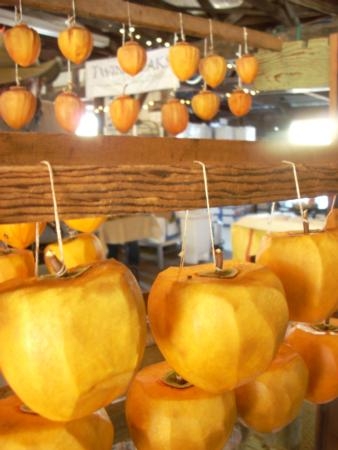
Drying whole Hachiya persimmons.
Cultivating California
Only in California could arid land be converted into the nation’s salad bowl.
In the late 1800s, University of California researchers discovered how to remove salts from the soils of the Central Valley, turning it into one of the most productive agricultural regions.
UC researchers continue to play a key role in agriculture today, keeping California the nation’s leading agricultural state, from dairies in Tulare to nut farms in Newberry Springs.
A new brochure highlights the breadth of UC Agriculture and Natural Resources’ impact. UC guidelines have helped farmers boost broccoli production. UC scientists have developed sweet-tasting citrus and strawberries to meet consumer demands. UC certifies more than 95 percent of wine grapevines grown in the state, providing a reliable supply of high-quality vines for California’s multibillion-dollar wine industry. Whether it’s managing invasive pests, promoting nutrition or sustaining small farmers, ANR serves California’s communities with a focus on advising, educating and searching for solutions.
For more information, read the Cultivating California brochure.

uc anr minibrochure cover s2


